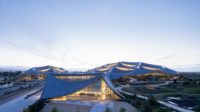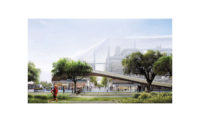Medtronic Mounds View Campus
Heart-saving devices are designed in a new collaborative employee environment.

Photo © George Heinrich Photography

Photo © Koyama Photography

Photo © Lucie Marusin

Image courtesy Opus Architects & Engineers

Image courtesy Opus Architects & Engineers

Image courtesy Opus Architects & Engineers






Medtronic, maker of implantable cardioverter defibrillators, pacemakers, and monitoring equipment for cardiac rhythm disorders, has a new 1.2 million-square-foot campus, Phase 1 of a 1.5 million-square-foot project that will eventually house 6,000 Medtronic employees. With a focus on innovation through collaboration, Medtronic’s new facility aims to redefine the way in which products are designed and brought to market.
Opus Architects & Engineers chose to team up with Julie Snow Architects in a collaborative design effort to arrange a program based on an interdisciplinary project team approach with that large and flexible floor plates. The design divides the program into three eight-story buildings with rectangular floor plates averaging 44,000 square feet. Glass links, lined with conference rooms, connect the three buildings and serve as a place for interaction. Here, overlapping three story spaces provide visual connectivity between floors and panoramic views of the landscape.
The buildings are oriented in the east-west direction, reducing the energy load, and they are offset along their east-west axis for a dynamic massing composition in response to existing site features. This shifting relationship is extended as a linear pattern on the landscape, tying the compositional logic of the buildings into their surroundings.
A healthy and pleasant work environment is created by the consistent access to daylight, open stairs, outdoor access, and two-mile walking path around the campus. Amenities include fitness and childcare centers, a coffee shop, convenience store, cafeteria, store, and bank. Rain gardens, indigenous plants, and efficient fixtures reduce water consumption more than 20 percent over a base building model. Other sustainable design strategies include the use of high albedo roof materials, no CFC HVAC systems, low or no VOC interior finishes with highly recycled content, structured parking, and the preservation of green space.
The building skin is designed to meet a strict cost model of 60 percent glass and 40 percent pre-cast concrete. Hence, the design team aimed for maximum effect with simple means. The solution is a striped composition of varying colors and pre-cast spandrel heights. Only three spandrel sizes and three colors are used, but are combined in an engaging and dynamic way that renders each building unique, reinforcing Medtronic’s image as a medical technology world leader that is innovative, fun, and full of life.
PeopleOwner: Architect: Personnel in architect's firm who should receive special credit: Grant Peterson AIA Project Lead Designer: Dan Young Dixon, AIA Project Designer: Ernesto Ruiz-Garcia Project Architect: Scott Cochrane AIA Architect of record: Associate architect: Julie Snow FAIA Interior designer: Engineer(s): Consultant(s): General contractor: Photographer(s): George Heinrich Photography (612-338-2092)
|
ProductsStructural system: Steel frame with composite concrete-on-metal-deck floor system. Exterior cladding: Concrete: Gage Brothers Insulation: Thermafiber Metal Panels: Peterson Aluminum Corp., McNichols (perforated) Roofing: Glazing: Window Film: 3M Dusted Crystal Doors: Wood doors: Algoma Hardwoods Upswinging doors, other: Clopay Hardware: Hinges: PBB Closers: LCN Interior finishes: Suspension grid: USG Demountable partitions: Accurate Partitions, Partition Systems Inc. Cabinetwork and custom woodwork: Calmar Manufacturing Lab casework: Fisher Hamilton Paints and stains: Benjamin Moore, ICI Paints, Devoe Coatings Wallcoverings: Knoll Textiles Floor and wall tile: American Olean, US Ceramic Tile, Italgraniti, Royal Mosa, Mirage, FLORIM Resilient flooring: Armstrong, Rickett Quartz, NORA Rubber Flooring, Tarkett Carpet: InterfaceFlor Commercial, Milliken Carpet Raised flooring: Tate Access Flooring Window Treatments: Mechoshade ThermoVeil, Springs Window Fasions Corner Guards: Hiawatha, Inc. Furnishings: Conveyance: |









